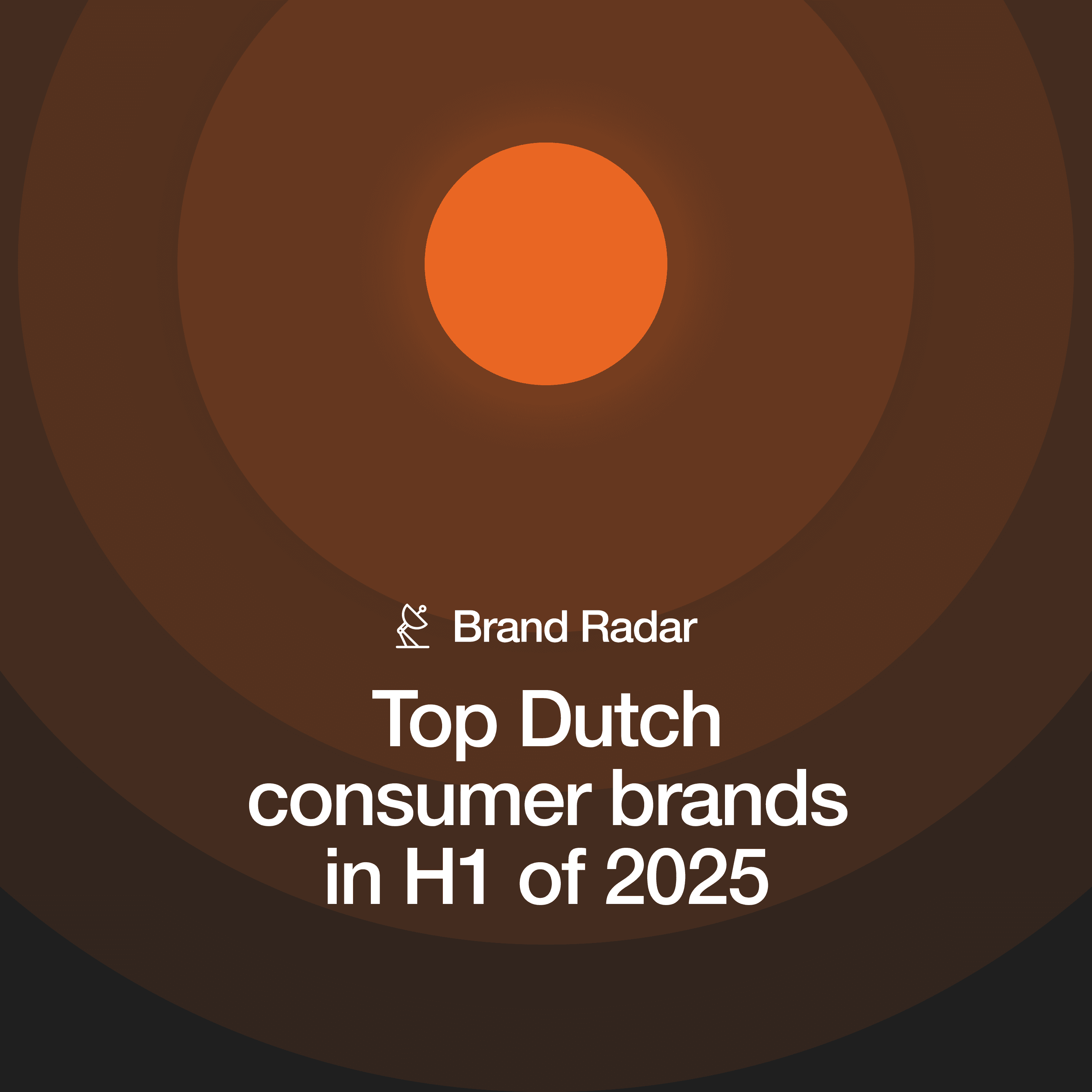
Written by
Aurelija Vycaite
Brand Radar
Who’s winning digital commerce in the Netherlands?
The digital commerce market is evolving rapidly: bankruptcies, M&As, leadership changes, international expansions - keeping a pulse on all that requires time and a lot of data.
But we believe that systematic digital metrics help reveal where brands are gaining momentum, where strategies are shifting, and which foundations are actually driving growth.
So here we are: back again 6 months later after the latest report. Now with H1 update, aiming to identify new trends among Dutch consumer brands.
If you're new here: this is what Conway Brand Radar does
Conway Brand Radar is an independent ranking that tracks the digital performance of consumer brands in the Netherlands. By analyzing publicly available signals like website traffic and growth, engagement metrics, headcount and recent news, we learn which brands are gaining or losing digital momentum.
This H1 2025 report analyzes +250 Dutch consumer brands - from giants like IKEA to emerging DTC players like Mother’s Earth.
Important context:
We track website traffic growth and digital engagement metrics, not revenue growth.
Traffic can increase for various reasons (viral moments, PR crises, bankruptcy, or genuine growth) so we don’t imply traffic growth = company success.
Only consumer brands are included (retailers and marketplaces like Bol.com will be added later in 2025)
Executive summary: the market at a glance
Dataset: 250+ Dutch consumer brands with online presence
Analysis period: Last 12 months analysis for YoY traffic growth and monthly metrics from June 2025.
Data: Semrush analytics, Linkedin, and company news research.
The average scores
When looking at Dutch digital commerce, averages lie. Here's why:
Mean traffic: 1013K visits/month
Median traffic: 72.2K visits/month
That 15x difference reveals extreme market concentration.
Mean YoY growth of traffic: 294% (distorted by viral outliers like Seepje, CN Supplements, or Mother's Earth)
Median YoY growth of traffic: 8.4% (the more realistic digital growth rate)
Mean headcount: 928 employees (brands with retail networks greatly increase this number)
Median headcount: 61 employees
Mean bounce rate: 49%
Market polarization
We analysed the traffic growth of the last 12 months among all the brands in our database.
63% (164) brands are growing (positive traffic growth):
14% (36) brands had +100% traffic growth
49% (128) brands had < 100% growth
37% (95) of brands are declining (negative traffic growth):
25% (65) brands have a decline that was steeper than 10%
12% (30) brands had a decline that was smaller than 10%


Market concentration
The Dutch consumer brands’ market isn't normally distributed.
Top 10 brands: Account for ~70% of total market traffic
Bottom 50%: Each gets less than 74K monthly visits
Conventional wisdom says bigger brands grow slower. Our data reveals a more complex reality:

Which brands are growing the most?
Some brands experienced astronomical growth that skews the entire market:
Mercer Amsterdam: 45600% (the new site launched in August 2024 so the growth number is skewed).
Seepje: 7,330% traffic growth (launched June 2024)
Clean Nutrition Supplements: 5,900% traffic growth (launched October 2024)
Top 10% performers (150%+ YoY traffic growth)

Top 25% vs Bottom 25%

What's common among the top-growing brands:
A few clear patterns emerge:
1. Built on values
Nearly a quarter of the fastest risers are responsible brands.
Seepje, Mother’s Earth, and The Good Roll are modern alternatives to legacy household names.
Tenue Soleil runs a preloved program and educates on sun care.
KASSL Editions is a certified B Corp.
2. Fueled by founder presence
Many of these brands are built around visible founders with social communities. They operate like creator-led businesses, blending commerce with social engagement and UGC.
Clean Nutrition Supplements, led by athlete Joel Beukers, loads of social content.
Sophia Mae, fronted by Monica Geuze, a well know TV personality and influencer.
ICON., driven by lifestyle and financial coach Samuel Onuha.
Josh V, built a content-rich experience and has a prominent founder Josh Veldhuizen.
3. A generational gap?
The top 25% of brands are, on average, 25 years younger than the rest of the brands. It could reflect a different business DNA. Brands born post-2000 were likely built for digital from the start. Those founded in the 80s or 90s may still be adapting structures designed for an earlier era.
Category benchmarks
We analyzed 9 major categories to understand sector-specific dynamics.


Fashion leads in volume, but not all segments win
Fashion remains the largest category and includes some of the fastest risers: Most Wanted (+902%), Hang Eleven (+530%), WAHTS (+342%), YAYA (+258%), and JOSH V (+211%).
In the premium and luxury tier, Travelteq (+316%) and PAUW (+130%) showed standout growth.
Among 6 out of 10 jeans brands grew their traffic more than 30%. Notable mentions: MUD Jeans (+2900%), Lois Jeans (+78%), and CHASIN' (+45%).
Streetwear and jewellery categories were stable. The average YoY traffic growth across all brands in each segment was just +11% for streetwear and +13% for jewellery.
Baby and children’s brands are quietly outperforming
Every brand in this category grew. The standouts: Wildride (+195%), Jollein (+94%), Nuna (+88%). The median growth for the category was +42%.
Most of these brands focus on DTC mobility products: carriers, strollers, cargo bikes, with strong positioning in safety, design, or independence from legacy retail.
Behind the scenes: analysis of recent company news
Using AI-powered agents to analyze publicly available data (including company news, investor updates, and official statements) we compiled a snapshot of key strategic moves shaping the market.
While not exhaustive, this provides a glimpse into where brands are focusing: leadership rotations, technology adoption, store expansions, strategic acquisitions, and new collaborations.
Leadership changes
Several brands announced major leadership rotations to steer their next growth chapters:
Ace & Tate appointed Lex van de Vliet as CEO in March 2025.
Naïf welcomed Gijs Krimp as CEO.
Kees Smit Tuinmeubelen named Kef van Helbergen as CEO in April 2025.
Moooi announced Anders Westerholm as incoming CEO from September 2025.
Naduvi and fonQ saw founder Itai Gross step down from both CEO roles.
Fairphone appointed Chandler Elizabeth Hatton as CTO.
QWIC introduced Rens Evers as commercial director.
Lucas Bols will see CFO Frank Cocx succeed Huub van Doorne as CEO in October 2025.
Expansion plans
Expansion plans remain strong, especially in physical retail. Even digitally native brands are investing in offline channels to deepen brand presence and reach new audiences beyond the Netherlands.
Dille & Kamille announced accelerated plans for Germany and France.
Yaya accelerated expansion with new stores in Belgium, the Netherlands, and Germany.
My Jewellery opened its 40th boutique in Belgium.
Anna + Nina opened its first store in London.
By Merrachi launched a flagship in Antwerp, extended a pop-up, and opened Villa MERRACHI in France.
Madaq, a brand founded in 2022, opens 4 new stores, and in total will operate 12 locations.
Aurélien entered Harrods with a full footwear collection.
MUD Jeans opened its first flagship in Amsterdam and expanded into the UK.
Mother’s Earth entered physical retail via Blokker stores.
SOPHIA MAE announced its first flagship and new product launches.
Pockies expanded into Japan after surpassing one million products sold.
Tech and digital wins
We saw targeted tech initiatives move beyond experimentation into measurable gains. AI, digital passports, and advanced personalization tools were core themes:
Garcia rolled out digital product passports across its Spring/Summer 2025 collection.
Samsonite integrated digital product passports in circular luggage.
Omoda launched a GenAI-powered online stylist to enhance shopping experiences.
Shoeby implemented AI-powered conversational commerce.
elho launched an Italian webshop in just 1.5 months.
Matt Sleeps achieved a 3X conversion uplift and 128% traffic increase through a phased, data-driven Black Friday strategy.
Acquisitions, investments, and bankruptcies
Strategic investments continue to reshape ownership and fuel growth ambitions:
Hunkemöller was acquired by Redwood Capital Management to accelerate innovation and global expansion.
Unilever sold De Vegetariche Slager to Vivera, closing in Q3 2025.
Alpine was sold by Vendis Capital to Gimv.
Joolz was sold to Bugaboo by Gimv in May 2025.
Swiss Sense secured €100 million refinancing to expand in Scandinavia and invest in digitization.
Bankrupcies:
BALR. files for bankruptcy in July, 2025.
Riviera Maison declared bankruptcy in June 2025.
Vanilia declared bankruptcy in February 2025.
New Optimist files for bankruptcy in July 2025.
Brand collaborations
Brand partnerships have become a common lever to grow audience reach and strengthen brand equity, signaling a strategic shift from pure growth marketing toward co-creation and shared storytelling:
Ekster x Travelteq joined forces for cross-category synergy.
Tenue Soleil x FOUR Amsterdam launched a children’s collection.
Yumeko x Joolz promoted fair organic cotton practices.
Flâneur launched a new music label with CNR + Matrefakt.
Conway Brand Radar tracks digital performance of Dutch consumer brands quarterly. This H1 2025 report analyzes 250 consumer brands. For personalised insights about your brand's position and growth opportunities, visit conway.expert





